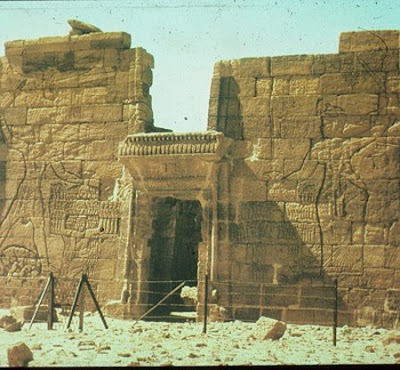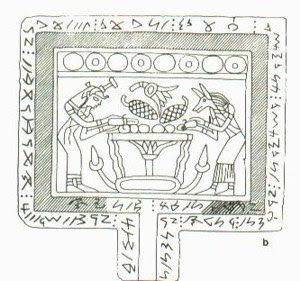
I will attempt to read the broken tablet. First of all it is hard to make out some of the signs on this piece, especially parts of line three(3) and five (5), but I will attempt to read the piece. Reading the piece from right to left we have the following:
Transliteration
1. m...e-ne...ap. ...
2. [s]....mlo.. nea...š... ..
3. m...p....b.. .ye..... s
4. e.....q....b. ...p...nea. ...
5. [o]...lo... n-ne...ml... .ne...s.. .mš....
Translation
"...(1)The great Commander and ancestor.... (2)[prop up] the inner heart at this time (of) the King....(3) m entreat the Ba to travel (and) prop up...(4)Register the wish (of) the Ba to solicit at this time....(5)[ Begin] to dispatch Goodness and the good spirit (of) the son of Mash.....
Vocabulary
ap, ancestor, father
m , great
e-ne, commander
e, register; vouchsafe; grant a boon
b, Ba
ml, spirit
mlo, innerheart, soul
s, son;to protect; to prop up
ye, to make; travel, voyage
nea, at this time;
ne, good
n-ne, Goodness
mš, Mash
lo, dispatch
o, begin
The so called word divider sign : equals -ne. The : is used to change verbs into nouns, or means good.
At the lion temple of Naqa, we find Natakamani on the left façade and Amanitore on the right. Under the feet of the ruling pair we find friezes of their defeated enemies.
There are a number of Meroitic hieroglyphics on the front of the Naqa Lion Temple. There are three columns of hieroglyphic inscriptions on under the falcon of King Natakamani. Reading from left to right we see the following
Transliteration
1. ter tel i ne
2. …ni-ne b-q r
3. ikh iy kh te b d r te
Translation
"1….the erection (of this structure) elevates (our) tradition [of building].2…brillian ce (is) also desired indeed.3…this spot bring Great light (and) also leave a legacy (of) unity." We can interpret the inscriptions and engraving from this part of the temple as follows:"King Natakamani smites the enemies of Meroe. The royalty "...[has made] the erection (of this structure) to elevate (as is our) tradition.2…Brillian ce (is) also indeed desired.3…This spot to bring Great light (to many and) also leave (to the Meroites) a legacy (of) unity."
This Stela dates back to the 2nd to 3rd Centuries. It is has a reddish-white undercoat. It comes from Grave 275, Karanog. The stela is located in Cairo, Egyptian Museum JE40229.
The couple Meteye and Abakharta stand under the inner wings of the sun disk. Meteye wares her hair with a topknot and cornrows. This man may be either Meteye's husband or father. (I am uncertain because the words ab-a can be interpreted as `[her] father'.
If this is the correct reading aba Kharta would mean `her father Kharta'.)The grave was excavated by Woolley-Randall- MacIver at Karanog.
The skeleton in the grave was of a woman. The pointed breast on the figure indicate that she was a young women. Standing side by side suggest that this man was her husband. Since the grave contained only one skeleton we can imagine that Abakharta was depicted on this stela to show his devotion to his wife.There are three sets of inscription on this stela.
There are inscriptions in front of Meteye and Abakharta, and an inscription between the legs of Abakharta.Reading from right to left beginning with the inscription between the legs of Abakharta, then the inscription before Abakharta and finally the one in front of Meteye we have the following:Inscription between Abakharta's legs.
P .. š ….o …."Pray for the patron to commence……"
Inscription in front of the man:
Wosi .. ne. Sore… yi-ne. Abkharta… ke ….lo …..wi-ne... a…kh…m…še.."
Translation
Isis the Good. Osiris the eternal. Abakharta gives permission (for) the offering of this Object of Respect (Meteye) to acquire greatness (and) protection."
Inscription in front of the woman:
Woš..i-ne…šore.. yi-ne..Meteye… qo …wi…ato ….mh…ene… š.. o-a….tene
Translation
"Isis the good. Osiris the eternal. Meteye , renew (her) honor down the path (to) abundant alms giving. The patron [Meteye] has commenced the Rebirth".
Funerary stelae of Prince Tedeqen, circa 100-200 B.C.

Woš-i-ne …Tdeqen …ne …^h …ml …. ol … ho ….lk …tene ..at …mlo …ne… p … rem … eš …. d …. o … tl … wi-ne … el …^h …tene ….ete …. eš …. d…. ot …. el … ^h … tene …^he …. ra …. Ke-ne-l ….l …d …tene.
Translation
[Oh] Good Isis (give) Tedeqen kha, grand inner heart (and) soul to behold the path of rebirth. The good inner heart prays to witness (its) manifestation. (This) bequeathal to open (and) elevate the Object of Respect (i.e., Tedeqen) gift (of the) Kha's rebirth (Oh Isis). You give the manifestation of the bequeathal prestige. The gift (of) the Kha's (and the) external body's rebirth . Indeed [Tedeqen] revitalization (will) be the rebirth of the bequeathal (of the Kha).
Offering Stela of Tablet of Tedeqen
Offering Stela of Tablet of Tedeqen
[………] lo…. wi-ne ….šo ….tk ….te
Translation:
"Dispatch (this) Object of Respect [Tedeqen] to live and to reflect (on good)—may (it go forth)."
Inscription on the funerary tablet reading from left to right and around the tablet :
Wosi …i-ne …a…. šore ….. yi-ne ….tedeqen ….qo-ne …ah ..d …s-ne-l …. d …h … lo-ne… me …n …tone …e ….ri-ne …..ke …. li-ne …..e … ri …ke …lo… ne … atom … lo ..ne ….el … h …..tene ….al …ml …ol
Translation
"Isis the Good, Osiris the eternal. Tedeqen to live good (and) to acquire a lasting legacy (of Good). The patron's legacy (is for) the Kha's transmigration , measure the Good Rebirth (now). Give withdrawal (to the Kha) for revitalization (and) exaltation. Register the sendoff (of the Kha) to invigorate the good offering (of Tedeqen). He is to be (re)born to transmit Good (as his) gift (to mankind). The Kha's noble (re)birth (of a) grand soul."

The most interesting Meroitic text concerning Apedemak is found on the votive tablet of Tañyidamani which is now found in the Paris Museum.
On this votive tablet Tañyidamani is depicted on the obverse side , and the god Apedemak on the reverse side.On the reverse side of the Tañyidamani votive tablet the god Apedemak is depicted wearing a short apron and hemhem crown.
On this votive tablet Apedemak also wears armlets, bracelets, a collar and pectoral. Inside a panel in front of Apedemak we find a cursive Meroitic inscription.The inscriptions in the panel on the reverse side of the votive tablet of King Tañyidamani make it clear that the king acknowledged the important role the god Apedemak played in his life. These inscriptions can be read either from right to left or top to bottom.
Reading from right to left we read:
TRANSLITERATION OF REVERSE SIDE OF VOTIVE TABLET OF KING TAÑYIDAMANI
Transliteration
1. w e to2. q tel3. w to si4.tone m-k5. d.[l]..r-i6.te i
TRANSLATION
1. You (it is Apedemak who) gives guidance.2. Revitalize support (for me King Tañyidamani).3. You guide (me) to satisfaction.4. (And ) much reverence (for your patron).5. Give (it) amicably (to me).6. May (it go forth).
Reading this same inscription top to bottom we find the following:
TRANSLITERATION OF THE REVERSE SIDE OF THE VOTIVE TABLET OF KING TAÑYIDAMANI
1. w q b-to d-te.2. e te to m ne l.3. toe i skr-i.
TRANSLATION
1. (Oh Apedemak) Guide and Make Honor (for your patron).2. Give here your (full) measure of Good indeed. 3. (It is) thou (Apedemak who) give(s) leave to eminence (for your patron).
References:
References:
I have written a detailed grammar of Meroitic but it is being considered for publication so I can not give you a copy of this text.You can find out more about my decipherment at the following sites:
Below is a paper that explains my decipherment.
Below is a paper that discuss the origin of writing in Africa.






No comments:
Post a Comment